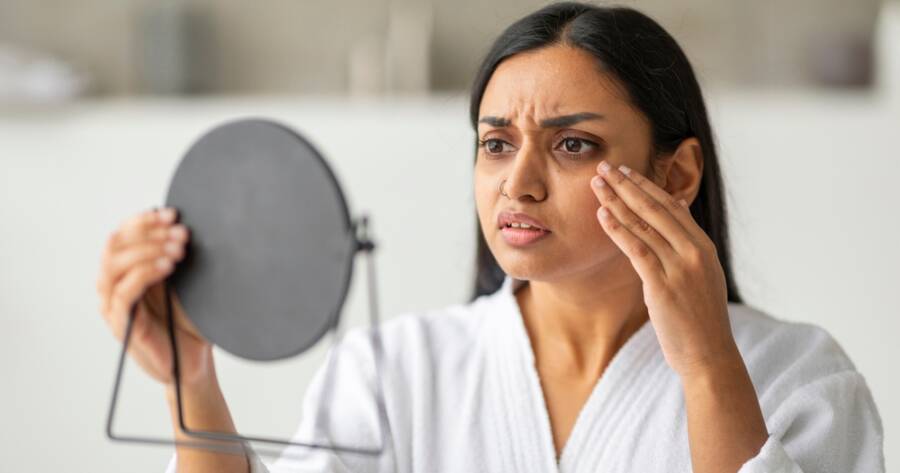The term “cortisol face” has gained attention in recent years as more people explore the connections between stress and physical health. Often used to describe a set of facial changes linked to chronic stress, cortisol face can include puffiness, redness, breakouts, and premature aging. But what exactly is going on, and why does stress seem to impact your appearance so significantly? In this article, we’ll dive into the science behind cortisol, its role in the body, and how it might affect your skin and overall facial aesthetics.
What Is Cortisol Face?
Cortisol face, also known as moon face, is a term that refers to the visible effects of prolonged stress on your skin, caused by elevated levels of the hormone cortisol. Cortisol face is swelling that builds up on the sides of your face making it look puffy. Known as the body’s primary stress hormone, cortisol plays a crucial role in regulating various bodily functions, including metabolism, immune response, and blood sugar levels. However, when stress becomes chronic, cortisol levels can remain elevated, leading to a range of physical changes, particularly in the face. These changes may include puffiness, acne, and even premature signs of aging. As more people become aware of the impact of stress on their overall health, cortisol face has emerged as a topic of concern in the realm of skincare and wellness.
How Does Cortisol Affect Your Skin?
Cortisol, often dubbed the “stress hormone,” is produced by the adrenal glands in response to stress. While it’s essential for managing short-term stressors, prolonged exposure to high cortisol levels can have detrimental effects on your skin. Cortisol triggers a cascade of physiological responses, including increased sebum (oil) production, which may lead to clogged pores and acne breakouts.
Additionally, cortisol may cause the skin to lose its elasticity by breaking down collagen, the protein responsible for keeping your skin firm and youthful. This breakdown can result in the appearance of fine lines and wrinkles. Cortisol also contributes to fluid retention, leading to puffiness and a swollen appearance, particularly around the eyes. By understanding the science behind cortisol’s impact on your skin, you can better appreciate the importance of managing stress to maintain a healthy complexion.
Signs and Symptoms of Cortisol Face
Cortisol face manifests through a variety of signs and symptoms that reflect the impact of chronic stress on your skin. One of the most noticeable symptoms is puffiness, especially around the eyes and cheeks, caused by cortisol-induced fluid retention. Acne breakouts are also common, as elevated cortisol levels increase oil production, leading to clogged pores.
In addition to these issues, you may notice that your skin appears dull or lacks its usual glow, which can be attributed to the hormone’s effect on blood circulation and skin cell turnover. Over time, the breakdown of collagen can lead to premature aging, with the early appearance of fine lines and wrinkles becoming more pronounced.
High cortisol levels can also cause other symptoms in the body such as:
- Weight gain around the midsection and upper back
- Easy bruising
- Flushed face
- Slowed healing
- Muscle weakness
- Severe fatigue
- Irritability
- Difficulty concentrating
- Headaches
- High blood pressure
If you’re experiencing any of these symptoms, it could be a sign that stress is taking a toll, making it essential to address the underlying causes.
Lifestyle Factors Contributing to High Cortisol Levels
Several lifestyle factors can contribute to elevated cortisol levels, ultimately leading to the development of cortisol face. Chronic stress is the most significant factor, whether it stems from work pressures, personal relationships, or financial concerns. Poor sleep habits, such as getting insufficient rest or having an irregular sleep schedule, can also cause cortisol levels to spike.
An unhealthy diet, particularly one high in sugar and processed foods, can also lead to inflammation and disrupt the body’s natural hormone balance, including cortisol production. Additionally, a lack of regular physical activity can prevent your body from effectively managing stress, leading to prolonged periods of high cortisol. By recognizing these lifestyle factors and making positive changes, you can reduce cortisol levels and minimize their impact on your skin.
Managing Cortisol Face: Tips for Reducing Stress and Improving Skin Health
Managing cortisol face requires a holistic approach that addresses both stress reduction and skincare. Start by incorporating stress-relief techniques into your daily routine, such as practicing mindfulness, meditation, or deep breathing exercises. Regular physical activity, like yoga or walking, can also help lower cortisol levels and improve overall well-being.
Ensuring you get enough sleep is crucial, as quality rest allows your body to repair and regenerate, keeping cortisol levels in check. In terms of skincare, focus on maintaining a gentle, consistent routine that includes hydration, sun protection, and products rich in antioxidants to support collagen production. Additionally, consider reducing your intake of sugary and processed foods, as a balanced diet can help regulate hormone levels.
Learn More About Cortisol
Cortisol face highlights the connection between emotional well-being and physical appearance, emphasizing the importance of a balanced lifestyle. Stress is an unavoidable part of life, but learning to manage it effectively can help mitigate its effects on your body and skin.
By incorporating stress-reduction techniques, nourishing your body, and practicing mindful self-care, you can take meaningful steps toward looking and feeling your best. While there’s no magic fix, small, consistent efforts often yield the most significant rewards over time.
